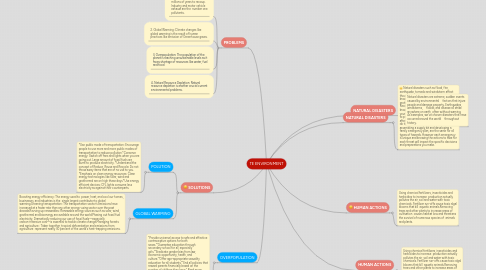
1. OVERPOPULATION
1.1. "Provide universal access to safe and effective contraceptive options for both sexes.""Guarantee education through secondary school for all, especially girls.""Eradicate gender bias from law, economic opportunity, health, and culture.""Offer age-appropriate sexuality education for all students.""End all policies that reward parents financially based on the number of children they have." Read more: Overpopulation Solutions - Everything Connects
2. PROBLEMS
2.1. 1. Pollution: Pollution of air, water and soil require millions of years to recoup. Industry and motor vehicle exhaust are the number one pollutants.
2.2. 2. Global Warming: Climate changes like global warming is the result of human practices like emission of Greenhouse gases.
2.3. 3. Overpopulation: The population of the planet is reaching unsustainable levels as it faces shortage of resources like water, fuel and food
2.4. 4. Natural Resource Depletion: Natural resource depletion is another crucial current environmental problems.
3. SOLUTIONS
3.1. POLUTION
3.1.1. *Use public mode of transportation: Encourage people to use more and more public modes of transportation to reduce pollution.*Conserve energy: Switch off fans and lights when you are going out. Large amount of fossil fuels are burnt to produce electricity. *Understand the concept of Reduce, Reuse and Recycle: Do not throw away items that are of no use to you. *Emphasis on clean energy resources: Clean energy technologies like solar, wind and geothermal are on high these days.*Use energy efficient devices: CFL lights consume less electricity as against their counterparts.
3.2. GLOBAL WARMING
3.2.1. Boosting energy efficiency: The energy used to power, heat, and cool our homes, businesses, and industries is the single largest contributor to global warming.Greening transportation: The transportation sector's emissions have increased at a faster rate than any other energy-using sector over the past decade.Revving up renewables: Renewable energy sources such as solar, wind, geothermal and bioenergy are available around the world.Phasing out fossil fuel electricity: Dramatically reducing our use of fossil fuels—especially carbon-intensive coal—is essential to tackle climate change.Managing forests and agriculture: Taken together, tropical deforestation and emissions from agriculture represent nearly 30 percent of the world's heat-trapping emissions.

